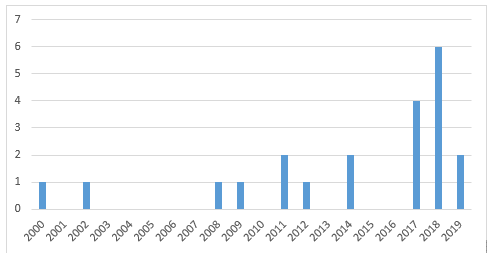
Streptococcus pyogenes: an Emerging Cause of Severe Pneumonia
2Microbiology, Hospital Universitario La Paz, Spain
3General Pediatrics and Infectious Diseases, Hospital Universitario La Paz, Spain
4Radiology, Hospital Universitario La Paz, Spain
5Pediatric Intensive Care Unit, Hospital Universitario La Paz, Spain
6Pediatric Emergency, Hospital Universitario La Paz, Spain
Background and Aims: Streptococcus pyogenes is an uncommon cause of community-acquired pneumonia(CAP) in children, but it seems to have increased in the last years. It is associated with severe disease, including longer duration of fever and hospital stay, development of complications (nectrotizing pneumonia, bacteremia, toxic shock syndrome) and larger pleural effusions, with higher rates of bacterial isolation in pleural fluid, compared with other bacteria. The aim of this study is to review the clinical aspects of S. pyogenes-CAP diagnosed in in our hospital during the last two decades.
Methods: Retrospective descriptive study of pediatric inpatients with S. pyogenes-CAP in the period 2000-2019.
Results: We included 21 patients (16 boys and 5 girls), median age [interquartile range–IQR] at diagnosis was 25 [20-43] months. Yearly distribution of cases is shown in Figure 1. Median hospital stay [IQR] was 22 [11-26] days. A total of 17 patients (80%) were admitted to the Intensive Care Unit (median [IQR] stay 4 [2-8] days). All patients but two developed pleural effusion that required chest tube insertion. Sixteen patients (76%) required respiratory support. Pleural fluid culture was positive in 17/18 (94%). Blood cultures were positive in 6/20 (30%). Twelve patients out of 21 (57%) had positive viral detections in nasopharyngeal aspirates (identified by multiplex PCR), being influenza the most frequent one (5 cases). Regarding complications, 8 patients (38%) developed necrotizing pneumonia, 9 (43%) had hemodynamic instability and 5 (23%) toxic shock syndrome. All patients received intravenous antibiotics, followed by oral antibiotics with complete resolution.

Conclusions: We have observed an increase in the number of cases of S. pyogenes-CAP in the last years. Most patients were preschoolers with severe pneumonia and pleural effusion. These infections require prolonged hospital stay and frequent Intensive Care Unit admission, as complications occur often. However, all patients achieved a full recovery.
Powered by Eventact EMS